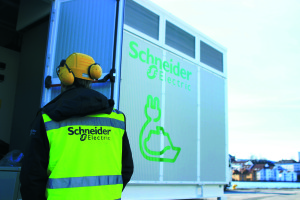La Méridionale – shore connection ready
 In 2015, La Méridionale and the port of Marseille (GPMM) have taken further steps towards their sustainable development by installing shore connection (or cold ironing) technologies in their facilities. The shore connection solutions will reduce the air pollution but also the noise and vibrations of vessels’ generators at the port.
In 2015, La Méridionale and the port of Marseille (GPMM) have taken further steps towards their sustainable development by installing shore connection (or cold ironing) technologies in their facilities. The shore connection solutions will reduce the air pollution but also the noise and vibrations of vessels’ generators at the port.
The three ships of La Méridionale generate about 500 annual stops in Marseille, which corresponds to a consumption of 2,150t of fuel per year. These stops can last up to 12 hours, thus generating an annual consumption of nearly 1,200t of diesel fuel, with significant consequences for the entire neighbourhood, particularly for citizens’ health.
“The district of Joliette, Marseille has evolved in the recent years”, said Olivier Varin, Deputy Director General in charge of operations within the shipping company. “More and more people settled there, and our generators that run continuously, generate both noise and air pollution that are no longer acceptable to local residents,” he adds.
Shore Connection On-board and On-shore
On the ship side, three ferries of La Méridionale, the Kalliste, Girolata and Piana, have been adapted to use ports’ electrical supply. This innovation will enable them to meet the increasingly stringent environmental regulations at berth, particularly, in terms of emissions. The system was supplied and installed, during vessels’ technical stops, by a joint venture of Schneider Electric and STX.
On port side, three positions will be powered with shore connection facilities. The installation in the port has been designed also, by Schneider Electric, with the minimum amount of civil works.
Also according to Olivier Varin, “this technology will prevent the release into the atmosphere of a quantity of carbon dioxide (C02) and particulate matter (PM) equivalent to what it is produced by 3277 cars making a daily round trip between Marseille and Aix, and the Nitrogen oxide released daily by 65,178 vehicles on the same course. It also allows us to perform maintenance savings and improving working conditions for our crews.”
Regulatory framework
The European Directive 2005/33 / EC sets a sulphur content of 0.1 percent maximum in fuel all ships at anchor in European ports. The Mediterranean coast is part of the regions that will integrate the sulphur emission controlled areas (ECA zone) in the medium term.






